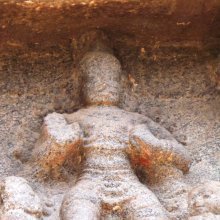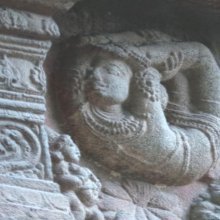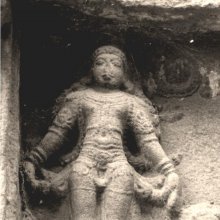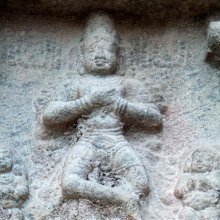Natyashastra, Nāṭyaśāstra, Natya Shastra, Natya-shastra: 8 definitions
Introduction:
Natyashastra means something in Hinduism, Sanskrit. If you want to know the exact meaning, history, etymology or English translation of this term then check out the descriptions on this page. Add your comment or reference to a book if you want to contribute to this summary article.
The Sanskrit term Nāṭyaśāstra can be transliterated into English as Natyasastra or Natyashastra, using the IAST transliteration scheme (?).
Images (photo gallery)
(+32 more images available)
In Hinduism
Natyashastra (theatrics and dramaturgy)
Source: archive.org: Natya ShastraThe Nāṭyaśāstra lays down very elaborate rules as to how the drama is to make mimicry of the exploits of men and their divine or semi-divine counterparts. It is due to rules of representation that the Hindu drama has been called by the later theorists ‘a poem to be seen’.
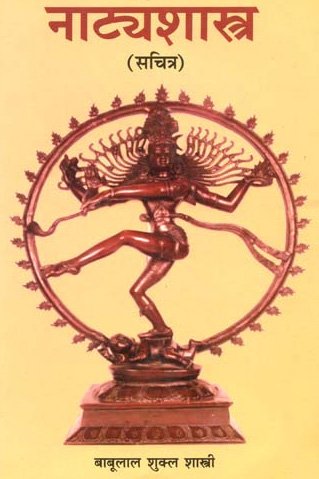
Natyashastra (नाट्यशास्त्र, nāṭyaśāstra) refers to both the ancient Indian tradition (shastra) of performing arts, (natya—theatrics, drama, dance, music), as well as the name of a Sanskrit work dealing with these subjects. It also teaches the rules for composing Dramatic plays (nataka), construction and performance of Theater, and Poetic works (kavya).
General definition (in Hinduism)
Source: WikiPedia: HinduismThe Natya Shastra (Sanskrit: नाट्य शास्त्र, Nāṭyaśāstra) is an ancient Indian treatise on the performing arts, encompassing theatre, dance and music. It was written during the period between 200 BCE and 200 CE in classical India and is traditionally attributed to the Sage Bharata.
The Natya Shastra is incredibly wide in its scope. While it primarily deals with stagecraft, it has come to influence music, classical Indian dance, and literature as well. It covers stage design, music, dance, makeup, and virtually every other aspect of stagecraft. It is very important to the history of Indian classical music because it is the only text which gives such detail about the music and instruments of the period. Thus, an argument can be made that the Natya Shastra is the foundation of the fine arts in India. The most authoritative commentary on the Natya Shastra is Abhinavabharati by Abhinavagupta.
Languages of India and abroad
Sanskrit dictionary
Source: DDSA: The practical Sanskrit-English dictionaryNāṭyaśāstra (नाट्यशास्त्र).—
1) the dramatic science, dramaturgy.
2) a work on dramatic representation.
Derivable forms: nāṭyaśāstram (नाट्यशास्त्रम्).
Nāṭyaśāstra is a Sanskrit compound consisting of the terms nāṭya and śāstra (शास्त्र).
Source: Cologne Digital Sanskrit Dictionaries: Cappeller Sanskrit-English DictionaryNāṭyaśāstra (नाट्यशास्त्र).—[neuter] = nāyyaveda.
Source: Cologne Digital Sanskrit Dictionaries: Aufrecht Catalogus Catalogorum1) Nāṭyaśāstra (नाट्यशास्त्र) as mentioned in Aufrecht’s Catalogus Catalogorum:—Oppert. 6019.
—by Bharata. Kh. 87. Kāṭm. 8. Bühler 543.
—by Vasantarāja. Quoted by Kāṭayavema Burnell. 173^a.
2) Nāṭyaśāstra (नाट्यशास्त्र):—by Bharata. Gov. Or. Libr. Madras 60 (and—[commentary]). Printed in Kāvyamālā 42. See Bharataśāstra.
3) Nāṭyaśāstra (नाट्यशास्त्र):—by Bharata. Rep. p. 10 (up to chapter 22).
Source: Cologne Digital Sanskrit Dictionaries: Monier-Williams Sanskrit-English DictionaryNāṭyaśāstra (नाट्यशास्त्र):—[=nāṭya-śāstra] [from nāṭya > nāṭa] n. = -veda, [Mālavikāgnimitra]
[Sanskrit to German]
Sanskrit, also spelled संस्कृतम् (saṃskṛtam), is an ancient language of India commonly seen as the grandmother of the Indo-European language family (even English!). Closely allied with Prakrit and Pali, Sanskrit is more exhaustive in both grammar and terms and has the most extensive collection of literature in the world, greatly surpassing its sister-languages Greek and Latin.
Kannada-English dictionary
Source: Alar: Kannada-English corpusNāṭyaśāstra (ನಾಟ್ಯಶಾಸ್ತ್ರ):—
1) [noun] = ನಾಟ್ಯವಿದ್ಯೆ [natyavidye].
2) [noun] the treatise on dance, which sets down the basic foundation for the Indian performing arts, esp. dance and its techniques, written by the sage Bharata.
Kannada is a Dravidian language (as opposed to the Indo-European language family) mainly spoken in the southwestern region of India.
See also (Relevant definitions)
Partial matches: Shastra, Natya.
Starts with: Natyashastrapravaktri.
Full-text (+2521): Uttamottamaka, Amreditayamaka, Udbhata, Shikhapasha, Vimarshanga, Narmagarbha, Gayiki, Dasharupa, Natyashastrapravaktri, Alunca, Gandhasevaka, Shilpakarini, Pushpagandika, Natyagara, Vishkambhaka, Trimudhaka, Trimudha, Pravibhavaka, Savidalambha, Veshayuvati.
Relevant text
Search found 47 books and stories containing Natyashastra, Naatyashaastra, Natya shastra, Nāṭya-śāstra, Natya-sastra, Nāṭya-śastra, Natya-shastra, Nāṭyaśāstra, Natyasastra, Nāṭyaśastra; (plurals include: Natyashastras, Naatyashaastras, Natya shastras, śāstras, sastras, śastras, shastras, Nāṭyaśāstras, Natyasastras, Nāṭyaśastras). You can also click to the full overview containing English textual excerpts. Below are direct links for the most relevant articles:
Puppetry in Assam (by Gitali Saikia)
Folk Drama: Origin and Development < [Chapter 1]
Costume of puppets of Assam < [Chapter 4]
Music used in puppetry of Assam < [Chapter 4]
On Ancient Greek and Ancient Indian Drama < [January – March, 1990]
Understanding Literature < [July – September, 2007]
The Aesthetics of Indian Dance < [January – March, 1985]
The Religion and Philosophy of Tevaram (Thevaram) (by M. A. Dorai Rangaswamy)
Chapter 4.3 - (d) Technical terms used by Arurar in relation to Dance and Music < [Volume 2 - Nampi Arurar and Mythology]
Chapter 4.3 - (a) Nataraja (the dance of Shiva) < [Volume 2 - Nampi Arurar and Mythology]
The Pantaranka or Pantarankam dance < [Volume 2 - Nampi Arurar and Mythology]
Dasarupaka (critical study) (by Anuru Ranjan Mishra)
Part 3-6 - Vyāyoga rules < [Chapter 5 - Vyāyoga (critical study)]
Summary of the Nāṭyaśāstra < [Introduction]
Part 3-6 - Vīthī rules < [Chapter 7 - Vīthī (critical study)]
Gati in Theory and Practice (by Dr. Sujatha Mohan)
Analysis of technical terms: Mārga and Deśī < [Chapter 1 - Nāṭya]
Gati in Yakṣagāna < [Chapter 4 - Practice of Gati]
Gati, as found in classical theatres of Kūḍiāṭṭam < [Chapter 4 - Practice of Gati]
Related products
